by Lisa Cooke | Sep 27, 2017 | 01 What's New, German, Translation tips |
Need help reading or translating German genealogical documents? These top German translation websites will help you identify and translate old German letters, words, abbreviations, street names, and occupations. These online resources are so good, even the experts use them! See how they can help your German family history.

Thanks to Katherine Schober of SK Translations and the instructor of the innovative online course on learning how to read the old German script and handwriting for this guest post.

Those of you who have braved the world of German genealogy may have run into a beautiful but solid genealogical “brick wall:” old German handwriting. “Kurrentschrift” (literally: “running script”) was the main form of writing in German-speaking lands until the mid-20th century. Unfortunately, this elegant script is often a major obstacle for modern-day genealogists searching for their German ancestors.
But it doesn’t have to be! While I recommend contacting a professional for the more complicated texts (I’d be happy to be of service), you can often make substantial progress in transcribing and translating old German documents with the help of several fantastic online resources.
Top 9 German Translation Websites and Resources
These are my favorite German translation websites for genealogy (and yes, I use them myself):
This is a great site for transcribing German genealogy documents, especially if you can only recognize some of the letters in a word. Choose either “words ending with” (Wörter mit Endung) or “words beginning with” (Wörter beginnend mit) and type in the first or last letters of the word you are deciphering.
For example, if you can only recognize “tum” at the end of the word, type in “tum” under “Wörter mit Endung”. It will then show you all the German words ending in “tum”, which may help you to recognize what your handwritten word could be.
This site offers a nice key of the Kurrent letters and the corresponding letters in our alphabet.
If you see an abbreviation in your genealogy document but aren’t sure what it stands for, you can type it into this website and it will provide you with a list of possible German words for your abbreviation.
Online German Dictionaries:
LEO, Online Dictionary by Langescheidt, and dict.cc are all extensive online German dictionaries. If one of these dictionaries doesn’t have a definition for a word, one of the other two might.
This is a very helpful translation site. Unlike Google Translate, it shows you words and phrases translated into English by actual translators and not machines. You receive the definition of the word, plus pages of various sample sentences that include your word/phrase in a contextual format.
This is a good site for finding the meanings of old-fashioned German words. Modern dictionaries often do not have definitions for the outdated words found in genealogy documents, but this online collection of old German dictionaries does. Knowledge of German required.
This website provides an A-Z list of old-fashioned German occupations with their modern-day German translation.
If you know that a word in your document is a street (“Straße”), but can’t figure out which street it is, use this site to help you out. First, type in the city in the “Ortsverzeichnis A-Z” (gazetteer). The site then pulls up a map of the city and an A-Z list of street names. If you know at least some of the letters in your street name, this list can help you to recognize the correct transcription of the word.
This site allows you to type in any word to see how it would look in Kurrentschrift. While everyone’s handwriting was, of course, different, it is nice to get an idea of what a word could have looked like in the old-fashioned script. For example, “Kurrentschrift:”

 Katherine Schober of SK Translations specializes in translating German genealogical and historical documents. She also teaches the online course that can help you learn how to read the old German script and handwriting. Learn more here.
Katherine Schober of SK Translations specializes in translating German genealogical and historical documents. She also teaches the online course that can help you learn how to read the old German script and handwriting. Learn more here.
She recently joined Lisa Louise Cooke on the Genealogy Gems Premium Podcast episode #151 with creative, use-in-any-language Google strategies for translating documents and identifying ancestral names and places.
Click here to see what else has aired on the Genealogy Gems Premium Podcast–and consider becoming a Premium member to get access to the entire Premium Podcast archive (it could see you through a whole year’s worth of workouts, commutes, or household chores!).
by Lisa Cooke | Aug 2, 2017 | 01 What's New, German, Maps |
Track down your German ancestors with Germany genealogy expert Jim Beidler. He’s here to share great tips for using MeyersGaz.org, the recent online collection of crucial historical German maps.
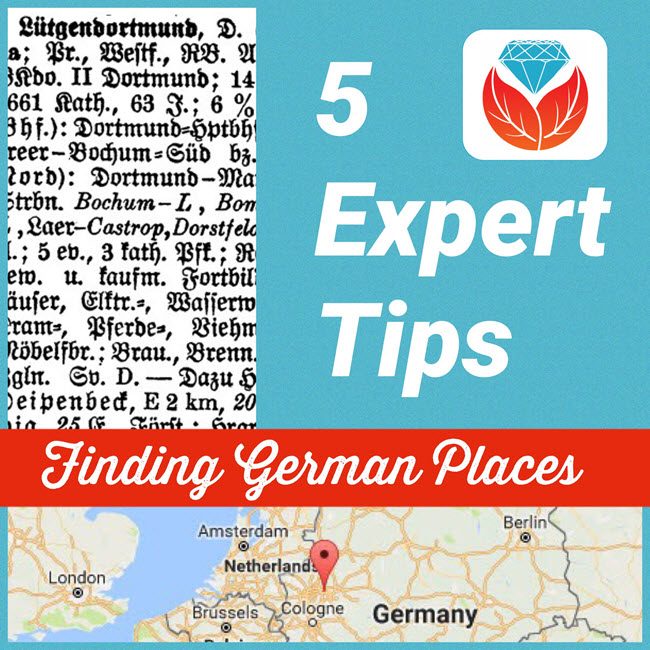
 The Meyers Gazetteer is a comprehensive, indexed map to every place name in the Second German Empire (1871-1918). It’s based on the 1912 book commonly known as “Meyers Orts” or the Meyers Gazetteer: Meyers Orts- und Verkehrs-Lexikon des Deutschen Reichs. Recently, a free version of the Meyers Gazetteer became available online at www.MeyersGaz.org.
The Meyers Gazetteer is a comprehensive, indexed map to every place name in the Second German Empire (1871-1918). It’s based on the 1912 book commonly known as “Meyers Orts” or the Meyers Gazetteer: Meyers Orts- und Verkehrs-Lexikon des Deutschen Reichs. Recently, a free version of the Meyers Gazetteer became available online at www.MeyersGaz.org.
5 Tips for Using the Meyers Gazetteer
German research expert Jim Beidler, author of Trace Your German Roots Online, recently offered Genealogy Gems followers five tips for using the site to trace your German roots:
1. Correctly locating the village of origin is often the key to finding Germany’s many locally-based records. The FamilySearch catalog, shown here, places German villages in the same political jurisdictions as Meyers-Ort (Second Empire), which can be incredibly helpful when looking for microfilmed church and other records. (Click here to learn more using the FamilySearch catalog and the end of their microfilm lending program.)
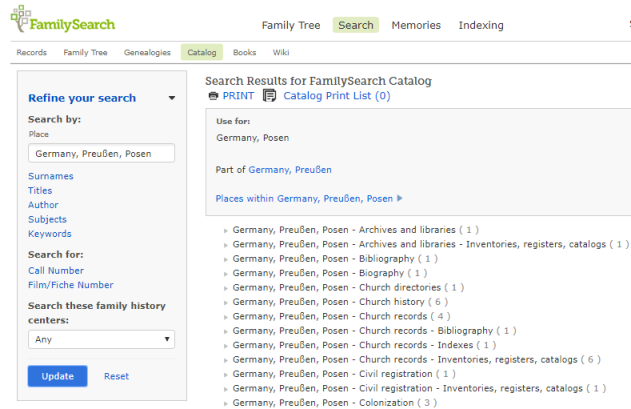
2. When searching the Meyers Gazetteer online, don’t use diacritical marks such as the umlaut (the two dots) or expand umlauted vowels (such as by turning an ä into an ae).
3. Filter search results to a specific German region to narrow results.
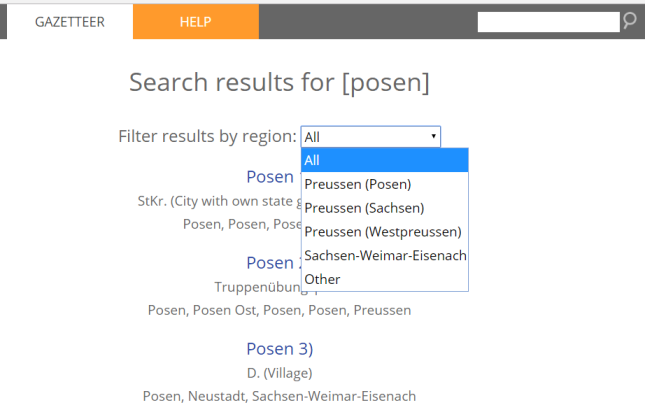
4. Explore places with an interactive map that allows you to zoom in and out and toggle back and forth between the past and present. After clicking on a search result, click Map. An interactive map will appear. Roll over Toggle Historical Map to see options to resize and to select whether the map shows you local jurisdictions, surrounding German civil registration offices (StdAs), and Catholic, Protestant and Jewish places of worship.
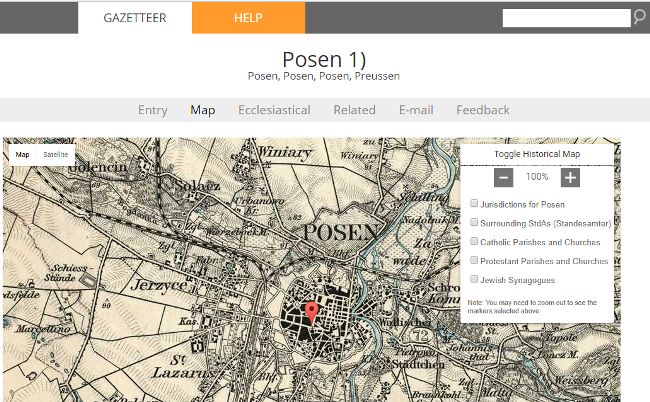
5. Click on Ecclesiastical to learn more about church parishes within 20 miles, which may have kept records on your family.
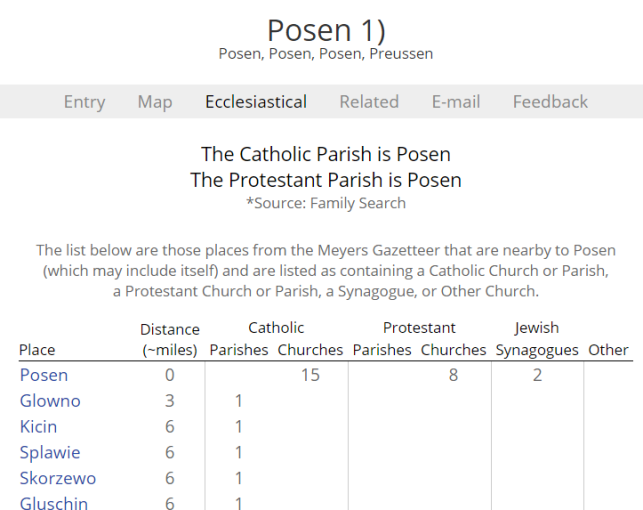
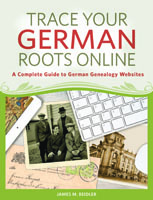
More from Jim Beidler on the Meyers Gazetteer
Genealogy Gems Premium members can sign in to our website and hear Jim go more in-depth on the Meyers Gazetteer for German genealogy research in Genealogy Gems Premium Podcast episode 143. Jim applies his decades of German research experience to the latest technological advances and brings you along for the ride!
Jim Beidler is the author of Trace Your German Roots Online, one of Family Tree Books’ top-selling genealogy guides.
by Lisa Cooke | Apr 15, 2017 | 01 What's New, German, Legacy Tree Genealogists, Maps |
Finding German hometowns can be challenging. Guest blogger Camille Andrus, a professional genealogist specializing in German research and Project Manager at Legacy Tree Genealogists shares 3 free German genealogy websites to put your ancestors on the map in the former German empire and modern-day Poland.
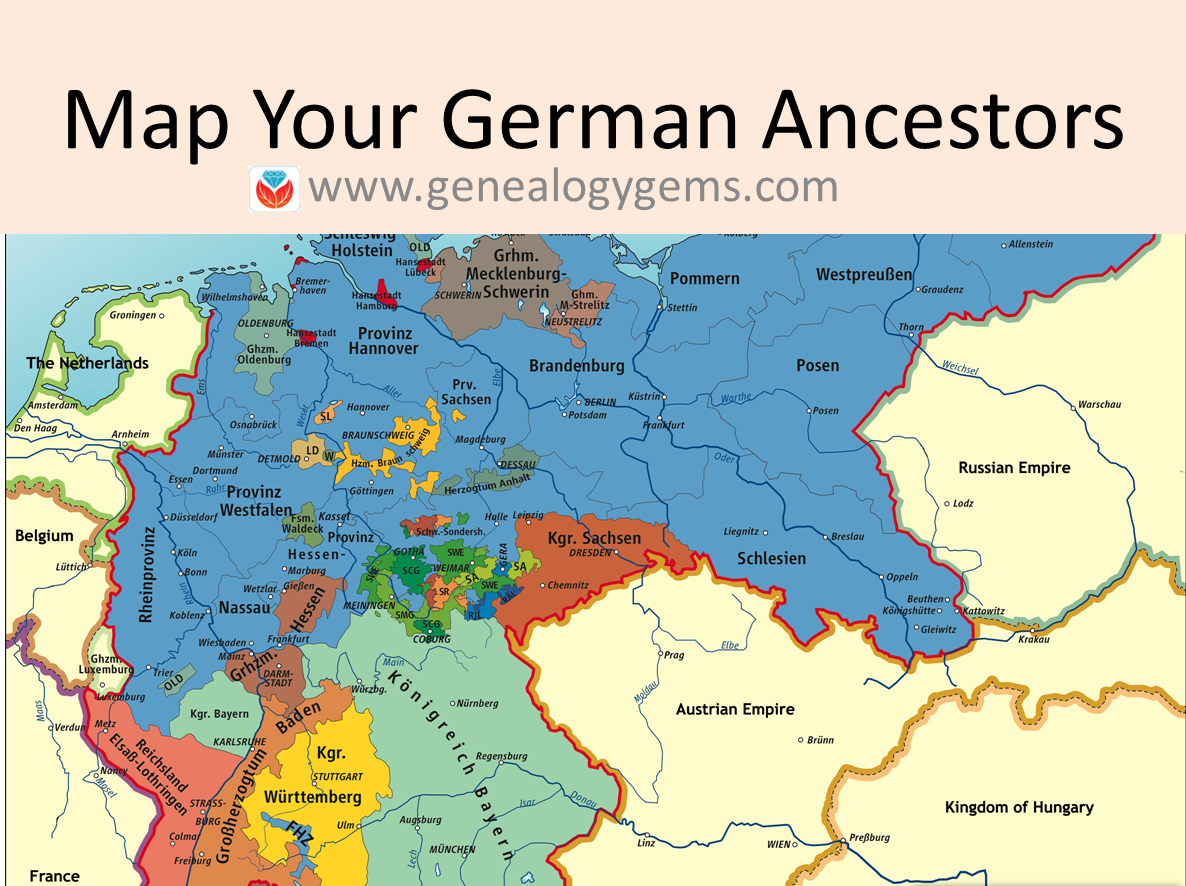
Map of German Reich 1871–1918. from kgberger, Creative Commons license, Wikipedia.com;
Anyone tracing German ancestors quickly finds themselves puzzling over maps in a region that has experienced a lot of change. Camille Andrus of Legacy Tree Genealogists recommends these 3 free German genealogy websites to help you navigate the former German empire–from Pomerania to Prussia to Poland. Here are her picks and her explanations for using them.
1. www.MeyersGaz.org
“For years, novice genealogists who found themselves embarking on the road of German genealogy were discouraged when needing to decipher an entry for their town in Meyers Orts- und Verkehrs-lexikon des deutschen Reichs (commonly known simply as Meyers or Meyer’s Gazetteer of the German Empire) due to the old German font in which the book was printed and the plethora of abbreviations that were used. To address this obstacle, the website www.MeyersGaz.org was created.
This online database not only explains the text and various abbreviations in the town entry that are found in the original printed version of Meyers, but also pinpoints the location of the town on both historic and modern maps, indicates the Catholic and Protestant parishes to which residents of the town would have belonged, and notes the distance from the town to all parishes within a 20-miles radius.
The database also allows users to search for a town using wildcards. This is especially useful when the exact spelling of a town is not known. For example, if the record on which you found the new town name indicated that the person came from Gross Gard…. where the second part of the word was smudged or illegible, you could simply put “Gross Gard*” into the database. In this case, the only two options would be Gross Garde in Pommern and Gross Gardienen in East Prussia. If you have a common town name such as Mülheim, you can filter the search results by province.”

Screenshot from MeyersGaz.org.
 Note: Genealogy Gems Premium website members can hear more about MeyersGaz on Premium Podcast episode 143.
Note: Genealogy Gems Premium website members can hear more about MeyersGaz on Premium Podcast episode 143.
2. Kartenmeister
“Kartenmeister is a database for towns which are found east of the Oder and Neisse rivers in the former German Empire provinces of East Prussia, West Prussia, Brandenburg, Posen, Pomerania, and Silesia. This area is now part of modern Poland. The database allows users to search for towns using either their German or Polish name.
Again, using Gross Gardienen as our example town, we learn that the Polish name for the town is now Gardyny and is located in the Warminsko-Mazurskie province. Like MeyersGaz.org, collaboration between users is encouraged. Individuals can enter their email address into a mailing list according to the town they are interested in and specify surnames they are researching in that town.”
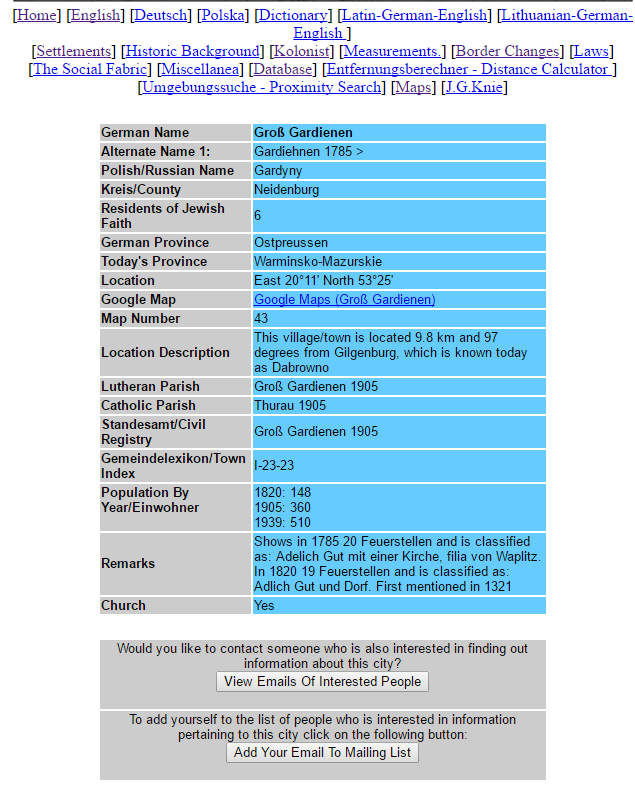
3. Lost Shoebox
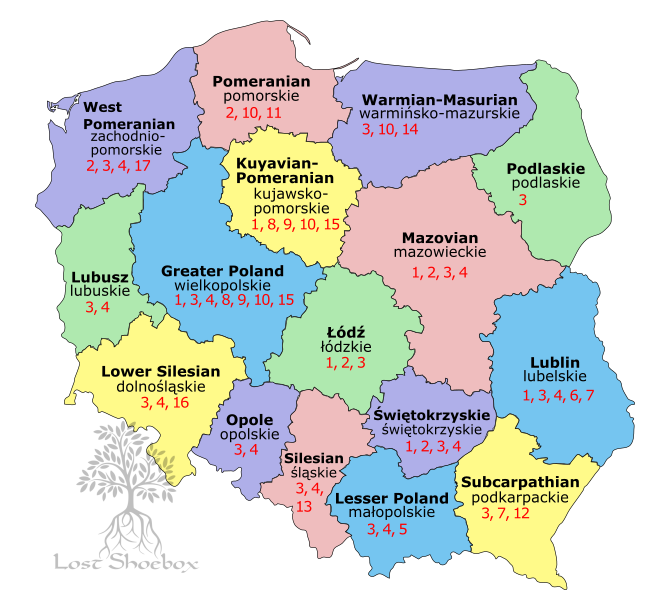
Map of Poland from Lost Shoebox shows where to find online records for each province.
“This website is an index to 17 websites focused on research in Poland. The list of websites corresponds with a map of Poland divided into its various modern provinces. Each number (representing a website) is listed on the map in each province for which it has records. Some websites are listed for nearly every province, while others show up for only one or two. The 17 websites featured on Lost Shoebox include either direct access to digital images, indexes to vital records, or lists of microfilms or other archival holdings.
If we were searching for records for Gross Gardienen or other nearby towns, we know from Kartenmeister that we would need to look in the Warminsko-Mazurskie province. The map shows the numbers 3, 10, and 14.” A corresponding key sends users to the appropriate websites.
“The third website on the list for the province brings us to the website for the Polish State Archive in Olsztyn. There are a plethora of digital images for both Evangelical church records and civil registration records available on this website.”
 Camille Andrus is a Project Manager for Legacy Tree Genealogists, a worldwide genealogy research firm with extensive expertise in breaking through genealogy brick walls. Her expertise includes Germany, Austria, German-speakers from Czech Republic and Switzerland and the Midwest region of the U.S., where many Germans settled.
Camille Andrus is a Project Manager for Legacy Tree Genealogists, a worldwide genealogy research firm with extensive expertise in breaking through genealogy brick walls. Her expertise includes Germany, Austria, German-speakers from Czech Republic and Switzerland and the Midwest region of the U.S., where many Germans settled.
Click here to learn more about Legacy Tree services and its research team

by Lisa Cooke | Mar 24, 2017 | 01 What's New, German, Records & databases
Are you researching German genealogy in the States? If so, you will love what we’ve dug up. German death lists are just the start. Also in this week’s new and updated genealogical record collections, Irish Quaker records, UK pensioners records, and a new product support announcement for Family Tree Maker software.
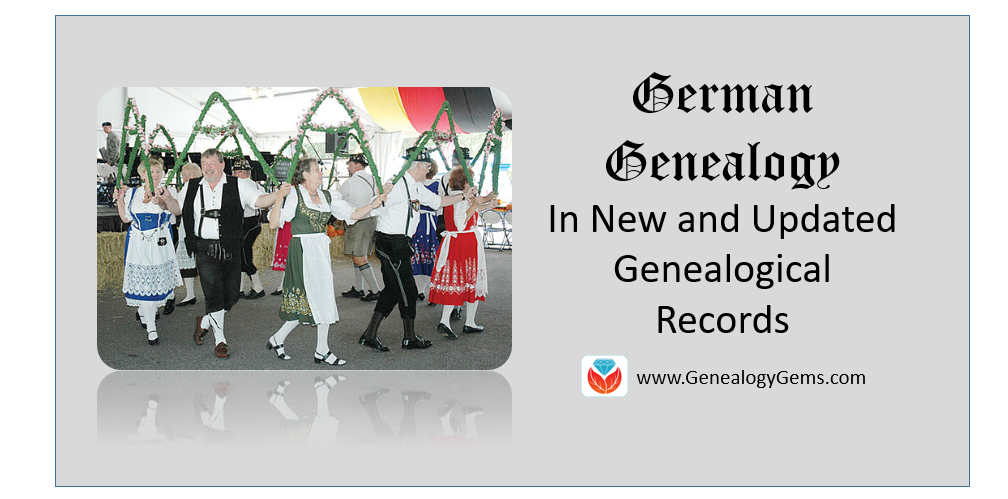
By Photos by Donna Hyatt (United States Army) [Public domain], via Wikimedia Commons.
German Genealogy in the States – Kentucky
You may not realize there was a large German population in Louisville, Kentucky, here in the United States. Our Book Club Guru, Sunny Morton, brought a new found website to our attention called German Genealogy Group. Among many other things, the German Genealogy Group has recently added newspaper death listings from the Louisville Anzeiger, a German newspaper from the Louisville, Kentucky area, to their website. The years covered are 1849-1865. Though only an index, the information provided will help you locate the newspaper itself.
Ireland – Quaker Birth Records
With over 302,000 new birth records from all over Ireland, you may finally find your Irish Quaker ancestors birth information. Ireland, Society of Friends (Quaker) births collection may help you uncover generations of your family tree. The amount of information listed on a birth record in this collection will vary, but most will include the child’s name, birth date, birth place, parish, and address. Most will also contain the parents’ names, addresses, and occupations.
Ireland – Quaker Marriage Records
Also at Findmypast, a collection titled Ireland, Society of Friends (Quaker) marriages has been updated. In fact, there have been over 20,000 new additions. These records will likely include data such as an occupation, parents’ names, and who attended the ceremony. As well as the names, address and marriage details of the newlyweds, parents’ names, an attendee list including names and dates of birth, and even details of the meeting may be found.
Ireland – Quaker Death & Congregational Records

By Holmes after Honthorst in 1654 [Public domain], via Wikimedia Commons. George Fox, Quaker founder.
Findmypast collection, Ireland, Society of Friends (Quaker) congregational records offers a wealth of knowledge about the role your ancestor might have played within the Quaker community. An additional 250,000 Irish congregational records have been added. Details of meetings and activities are just a sampling of what you will find. These records include a transcript as well as an image of the original handwritten record.
Ireland – Quaker School Records
Over 9,000 new records have been added to the Findmypast collection titled Ireland, Society of Friends (Quaker) school records. This collection covers six different schools and dates back as far as the 1700s. The records are compiled from various Quaker school registers and lists. Each entry includes both a transcript and an image of the original document. Details contained in each record will vary, but most will list the pupils name, age at last birthday, school and department, admission year, leaving year, parents’ names, and their occupations.
British Newspaper Archive Announcement
The British Newspaper Archive has recently announced a major new milestone in their project to digitize up to 40 million newspaper pages from the British Library’s vast collection of historic British & Irish newspapers. Following the addition of a newspaper for the country’s smallest county, Rutland, the Archive now covers at least one title from each of the country’s 48 counties and is now available to search and explore.
As part of this push to improve the British Newspaper Archive experience, a new “In Pictures” feature has also been added.
The British Newspaper Archive now contains over 18.7 million pages from 747 titles from England, Wales, Scotland, and Ireland and spans nearly 300 (1709-2003) years.
United Kingdom – Chelsea – Pensioner Service Records
Fold3.com has a collection titled UK, Royal Hospital Chelsea Pensioner Soldier Service Records. This collection includes those who would have been eligible to receive a pension from the British Army between 1760-1920.

The collection contains records for British soldiers (not officers) who received a pension from the British Army. They typically do not include records for soldiers who died in service or who were discharged early and did not receive a pension.
Some records contain more information than others, and pension documents after 1883 typically have more details regarding the soldier such as, information about next of kin, details of marriage, and children. Common details may include age, birthplace, service details (including any decorations,) physical description, previous occupation on enlistment, and the reason for discharge to pension. Documents that are most common include:
On Fold3, the records in this collection are organized as such:
- For the period 1760-1872, the documents are arranged alphabetically by name within regiment, including militia to 1854.
- From 1873-1882, the documents are arranged alphabetically under cavalry, artillery, infantry and corps.
- From 1883-1913, two alphabetical sequences for the entire army for discharge papers are arranged by range of surname and date 1883-1900 and 1900-1913.
United Kingdom – Leeds – Cemetery Burial Registers
Not everything is on the Genealogy Giants (meaning Ancestry, Findmypast, FamilySearch, or MyHeritage.) The Leeds General Cemetery Burial Registers Index is free and available to search online. This database of transcriptions covers all entries in the burial registers of the Leeds General Cemetery and covers the years of 1835-1992. There are 97,146 entries in the index. Digital images of the registers are available to view alongside the transcribed data.

Search by surname of deceased or surname of the parents. Information found on the record will vary, but you are likely to find the name of the deceased, date of death, age at death, parents names, occupation, and cause of death. This is a great resource if you have been having trouble finding a civil death record.
United Kingdom – Sheffield
If you had ancestors who lived in the Sheffield area, you will find this next website a great help to your research. The Sheffield Indexers website provides full, online, searchable indexes to numerous collections, for free. These collections include, but are not limited to:
- 1841 Sheffield Census
- Cemetery records
- Burial records
- School records
- Directories
Be sure to check out their extensive indexes!
Family Tree Maker Announcement
Last year, Ancestry.com announced the purchase of Family Tree Maker desktop software by Software MacKiev. Their goal has always been to maintain the capability to share your family tree data between files on your computer and your personal Ancestry online trees. They’ve been working on a new Ancestry gateway with Software MacKiev to use in their Family Tree Maker 2017, which will be available soon.
What you should know (hat tip: Ancestry.com):
- TreeSync will be replaced by Software MacKiev’s FamilySync™. In the new FamilySync, Ancestry’s search, merge, and Ancestry hints will all work as they do now for users who sync with their Ancestry trees.
- FamilySync will be available only in Software MacKiev’s Family Tree Maker 2017 edition, which will be released on March 31, 2017.
- The upgrade is free for all users who purchased a copy of a MacKiev Family Tree Maker edition since March 1, 2016. Those with previous Ancestry editions, or who got a free copy of Family Tree Maker 2014.1 or Mac 3.1, are eligible for discounted upgrades. The pre-order upgrade is $29.95 for those who sign up for Software MacKiev’s mailing list before March 29 and the upgrade will continue to be a discounted price ($39.95) for a limited time after March 29.
- Between Wednesday, March 29 and Friday, March 31, there will be a short period where syncing functionality may be interrupted as Software MacKiev rolls out their new syncing technology.
- As of March 29, 2017, Ancestry will no longer be supporting TreeSync, given the introduction of Software MacKiev’s FamilySync™. Software MacKiev will continue to handle all related customer questions for Family Tree Maker. Visit Software MacKiev’s Family Tree Maker Support Center at support.familytreemaker.com if you have questions.
More on German Genealogy in the States
 German Newspapers in America is a virtual conference OnDemand video class by Jim Beidler. Stateside ethnic newspapers are a revealing resource for those searching their German ancestors. In this video you’ll learn:
German Newspapers in America is a virtual conference OnDemand video class by Jim Beidler. Stateside ethnic newspapers are a revealing resource for those searching their German ancestors. In this video you’ll learn:
-
- How newspapers are helpful for your genealogy
- The special role of German-language newspapers
- Special concerns such as fonts
- How to access German language newspapers
by Lisa Cooke | May 13, 2016 | 01 What's New, Records & databases
 Here’s this week’s roundup of new genealogy records online. Highlights: Canadian marriages, German emigrants, Philippines civil registrations, Russian and Ukrainian church records and Michigan marriages.
Here’s this week’s roundup of new genealogy records online. Highlights: Canadian marriages, German emigrants, Philippines civil registrations, Russian and Ukrainian church records and Michigan marriages.
CANADA – MARRIAGES. A new collection of district marriage register images for Ontario, Canada (1801-1858) is now free to browse at FamilySearch.org. Most entries are for the 1830s-1850s.
GERMANY – EMIGRANTS. The (former) Grand Duchy of Oldenburg Emigrants database just passed the 100.000 person mark. According to a note from the site host, “The database contains beside the emigrant itself also the family members we could trace in Germany or the Country to which he migrated.” Learn more at this blog post from the Oldenburgische Gesellschaft für Familienkunde. Click here to hear online German records expert Jim Beidler talk about new German records online.
PHILIPPINES – CIVIL REGISTRATIONS. FamilySearch.org has added 1.7 million+ browsable records to an existing collection of Philippines national civil registration records (1945-1984). These are described as “marriage and death certificates from various localities,” excluding Manila, for which there is a separate database.
RUSSIA – CHURCH. Nearly half a million browsable records have been added to a free FamilySearch.org collection of church books for Tatarstan, Russia (1721-1939). These are described as “images of births and baptisms, marriages, deaths and burials performed by priests of the Russian Orthodox Church in the republic of Tatarstan.” More records are being added as they are available.
UKRAINE – CHURCH. Another 205,000 browsable records have been added to a free FamilySearch.org collection of church book duplicates for Kyiv, Ukraine (1734-1920).
U.S. – MICHIGAN – MARRIAGES. FamilySearch.org has added more than 60,000 indexed names to its collection of Michigan county marriage records (1820-1940) and another 2000+ names to its collection of Michigan church marriage records (1865-1931).
 Thanks for sharing this post about new genealogy records online with your genealogy buddies on your favorite social media sites! We love spreading good news.
Thanks for sharing this post about new genealogy records online with your genealogy buddies on your favorite social media sites! We love spreading good news.




 Katherine Schober of SK Translations specializes in translating German genealogical and historical documents. She also teaches the online course that can help you learn how to read the old German script and handwriting. Learn more here.
Katherine Schober of SK Translations specializes in translating German genealogical and historical documents. She also teaches the online course that can help you learn how to read the old German script and handwriting. Learn more here. 

 The Meyers Gazetteer is a comprehensive, indexed map to every place name in the Second German Empire (1871-1918). It’s based on the 1912 book commonly known as “Meyers Orts” or the Meyers Gazetteer: Meyers Orts- und Verkehrs-Lexikon des Deutschen Reichs. Recently, a free version of the Meyers Gazetteer became available online at
The Meyers Gazetteer is a comprehensive, indexed map to every place name in the Second German Empire (1871-1918). It’s based on the 1912 book commonly known as “Meyers Orts” or the Meyers Gazetteer: Meyers Orts- und Verkehrs-Lexikon des Deutschen Reichs. Recently, a free version of the Meyers Gazetteer became available online at 









 Camille Andrus is a Project Manager for Legacy Tree Genealogists, a worldwide genealogy research firm with extensive expertise in breaking through genealogy brick walls. Her expertise includes Germany, Austria, German-speakers from Czech Republic and Switzerland and the Midwest region of the U.S., where many Germans settled.
Camille Andrus is a Project Manager for Legacy Tree Genealogists, a worldwide genealogy research firm with extensive expertise in breaking through genealogy brick walls. Her expertise includes Germany, Austria, German-speakers from Czech Republic and Switzerland and the Midwest region of the U.S., where many Germans settled.




 German Newspapers in America is a virtual conference OnDemand video class by Jim Beidler. Stateside ethnic newspapers are a revealing resource for those searching their German ancestors. In this video you’ll learn:
German Newspapers in America is a virtual conference OnDemand video class by Jim Beidler. Stateside ethnic newspapers are a revealing resource for those searching their German ancestors. In this video you’ll learn: Here’s this week’s roundup of new genealogy records online. Highlights: Canadian marriages, German emigrants, Philippines civil registrations, Russian and Ukrainian church records and Michigan marriages.
Here’s this week’s roundup of new genealogy records online. Highlights: Canadian marriages, German emigrants, Philippines civil registrations, Russian and Ukrainian church records and Michigan marriages. Thanks for sharing this post about new genealogy records online with your genealogy buddies on your favorite social media sites! We love spreading good news.
Thanks for sharing this post about new genealogy records online with your genealogy buddies on your favorite social media sites! We love spreading good news.